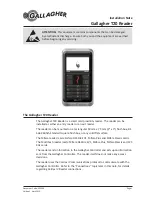
Manual PCI-A12-16A
5
Chapter 1: Introduction
The card is a multifunction high-speed analog-to-digital converter card for use in 5-volt and 3.3-volt PCI bus
computer slots. With this card installed the computer can be used as a precision data acquisition and control
system or as a signal analysis instrument.
Description
The card accepts up to eight differential or 16 single-ended analog input channels. Inputs are protected
against over-voltage conditions up to +35 volts and typically survive static discharges beyond 4000 volts. The
channel input configuration is software selectable. When using the card in differential mode the common
mode rejection ratio is a minimum 80dB at 45KHz and the common mode voltage rejection capability is +11V.
The input signals are amplified by an onboard instrumentation amplifier to provide voltage ranges of 10, 5,
1.25-6.25, and 1.25-3.75 volts unipolar and ±10, ±5, ±2.5 and ±1.25 volts bipolar. In addition, you can read 4-
20 mA current inputs by manually installing jumpers to utilize onboard resistors. In this case, the current input
is converted to an analog voltage range of 1.25-6.25V with full 12-bit resolution and there can be up to eight
inputs. Each channel must be dedicated to either voltage or current.
This card contains an industry standard 12-bit successive-approximation analog-to-digital converter (A/D) with
a sample and hold amplifier input. Under ideal conditions throughput of over 100,000 conversions per second
is possible.
This card has a 4k samples FIFO data buffer and a 4k words point list buffer. These buffers give capability for
full-speed counter-driven background data-acquisition with no computer interaction until the data FIFO needs
draining. This allows 100kHz data to be taken with little processor overhead.
A/D conversions may be initiated in any of three ways: (a) software command, (b) an on-board programmable
timer, or (c) direct external trigger. In turn, data may be transferred to the computer by any of three software
selectable methods: (a) polling for end-of-conversion (EOC), (b) polling for a half-full FIFO, or (c) a half-FIFO
interrupt.
Input System Expansion
This card can be used with up to 16 external AIM-16P analog input expansion cards. Each AIM-16P card
provides capability for 16 differential inputs and thus can be used to provide a maximum of 256 analog inputs
per combination of analog input expansion cards and a single A12-16A. The initial AIM-16Ps are connected to
the card by a special cable adapter and ribbon cable. Additional AIM-16P units are connected by daisy-
chaining with ribbon cables. In the normal system configuration each AIM-16P is connected to a single-ended
input of this card. However, if interconnection cable noise becomes problematic or if long cables are required,
then the AIM-16P cards can be connected to the differential inputs of the card. Using the differential
connection allows better monitoring of remote locations because noise will be reduced by the common mode
noise rejection capability of the card. (Note: In this configuration, the maximum number of inputs that can be
handled is 128.)
Note: If the VRef from the card is to be used to power a bridge or other apparatus connected to the AIM-16,
then pin 28 on J1 of the the card must be grounded. Consult the factory to obtain a specially modified card
that implements this option.
The control register at base 3 provides channel and gain control bits for use with submultiplexers
like the AIM-16. SEL3-SEL0 are typically used for channel, and G2-G0 are used for gain. If no submulitplexer
is being used, it is a good idea to use SEL3-SEL0 as ID tags. These values will comprise the top four bits of
the data returned from the A/D converter.







































